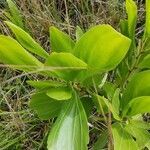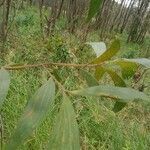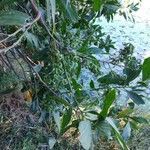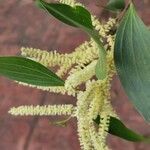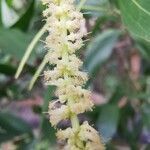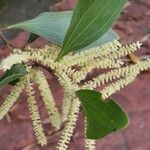Tree, up to 27 m high, bole straight, up to 13.5 m, 45 cm in diameter; crown spreading. Branchlets acutely triangular, sometimes scurfy but soon glabrous. Phyllodes ± straight or straight along the basiscopic margin and curved along the acroscopic margin, acute, up to 25 by 3.3-9 cm, 2-5 times as long as wide, dark green, usually covered by a whitish bloom when young, major veins and margins not yellowish, pulvinus 0.5-0.8 cm, with a basal gland, circular, c. 1.5 mm in diameter, ± sunken into the petiole, with a narrow orifice, main longitudinal veins 4 (or 5), running contiguously at the base near the basiscopic margin, and with several fine anastomosing secondary veins. Spikes rather lax, 8-11 by 0.65-0.9 cm, solitary or paired in the axils of the distal leaves, on pubescent or greyish white tomentose peduncles, 1-1.5 cm long. Flowers white, cream, greenish, or pale yellow, pentamerous. Calyx broadly cupular, 0.6-0.8 mm, pubescent to tomentose; lobes 0.1-0.2 mm. Corolla 1.2-1.5 mm, with reflexed oblong lobes c. 0.8-0.9 mm. Stamens up to 3.5 mm. Ovary sessile, puberulous. Pod brown, linear, coiled, up to 10 by 0.3-0.5 cm; valves membranous to slightly woody, depressed between the seeds, glabrous, veins inconspicuous. Seeds held longitudinally in pod; black, glossy, rectangular, 3-5 by 2 mm; areole 2.1 by 1.2 mm, open towards the hilum; funicle folded and forming a fleshy orange aril.
An evergreen tree. It grows to 30 m high and spreads about 5 m across. The trunk can be 15-45 cm thick. Sometimes the trunk is fluted at the base. The stem is slender and the bark is brown with cracks. The branches are triangle shaped in cross section. The leaves (phyllodes) are egg-shaped. They are 10-25 cm long. The leaves can be 5-10 cm wide. There are 4 veins running along the leaf. The tip of the leaf is blunt. Commonly the leaves are dark green. The flowers are white rods. They can be 6-10 cm long. Either one or two occur in the angles where leaves join. The flower stalks are 1 cm long and hairy. The pods are light brown. They are long (5 cm) and slender (3-5 mm). The pods are twisted or coiled. The seeds are black and rectangular. They are about 5 mm long. They are shiny and have an orange stalk where they join the pod.
